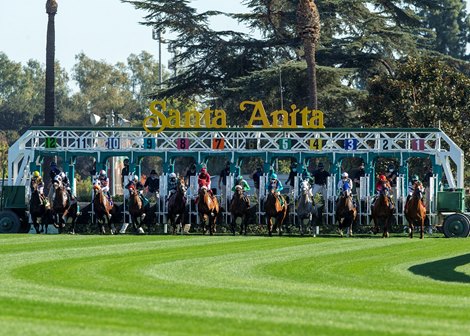During its monthly meeting June 20 at Cal Expo in Sacramento, Calif., the California Horse Racing Board reluctantly passed a compromised split that will fund the CHRB before the regulator’s fiscal year begins July 1.
The changes raise regulatory costs for California fair tracks that run Thoroughbreds and nighttime tracks that largely race Quarter Horses and Standardbreds. Conversely, the proportion of regulatory costs for Santa Anita Park and Del Mar, the chief Thoroughbred racetracks in the state, are now lower than under the prior model—though the two tracks still pay the majority of the costs necessary to support the CHRB’s $18.2 million budget.
The regulator’s funding action was necessary when industry stakeholders could not agree on an equitable allocation of costs that the CHRB believes meets legal requirements. Meetings between racetracks and CHRB commissioners took place over a series of weeks before Thursday’s meeting, with little middle ground found.
The approved funding split does not place as much of a burden on Santa Anita and Del Mar, the state’s highest revenue-generating racetracks, but it was not as favorable to them as a handle- or race dates-based allocation would have been. Los Alamitos Race Course, which runs much of the year with a meet of Quarter Horses and lower-level Thoroughbreds with some short afternoon higher-quality Thoroughbred meets, argued for a phased-in approach in which tracks other than Santa Anita Park and Del Mar would contribute to a higher percentage of regulatory costs.
Most agreed that tracks should be responsible for their direct costs of operating a race meet to fund testing, regulatory veterinarians, stewards, and other positions essential to CHRB operations. Indirect costs, the largest portion of the CHRB budget, were largely the subject of debate.
“We believe you should pay for what you use. We don’t think paying for what you use is a radical notion,” said Eric Sindler, general counsel for The Stronach Group, which operates Santa Anita Park as 1/ST Racing.
Some track representatives argued that dramatic cost increases to the mixed-breed evening programs at Los Alamitos and the Standardbred meet at Watch And Wager would be detrimental to already fragile California tracks with little funds to spare.
Purses have been overpaid at numerous California racetracks, resulting in purse cuts. Unlike other leading racing states, California does not have gaming to bolster track profits and purses.
Though the CHRB said it was required to change its funding mechanism based on its legal interpretation of state law, commissioners Wendy Mitchell and Damascus Castellanos pointed out that the need to alter the funding model came to the forefront not long after the CHRB chose not to redirect simulcast money from Northern California to Southern California after 1/ST Racing announced the closure of Golden Gate Fields in Northern California.
“This is a situation where people didn’t like the decisions that were made. We didn’t go along with what everyone wanted us to do (during) previous meetings, and I think this is, to be honest, punitive,” Mitchell said in her last meeting before her scheduled departure from the CHRB board. “And so that’s disappointing. … If the (approved allocation) is where we go because it’s the best compromise that we can come up with, I guess I’ll sign off on that. … I think the timing is suspect.”
Del Mar’s fees are expected to be about $4.68 million, compared to $5.35 million under the prior funding method, according to a CHRB-produced spreadsheet. Their decreased fees will be offset by higher charges to other tracks in the state.



)






